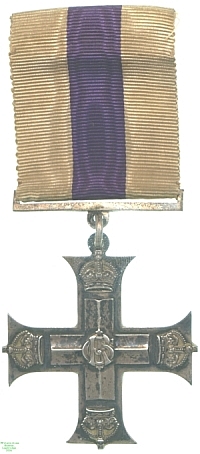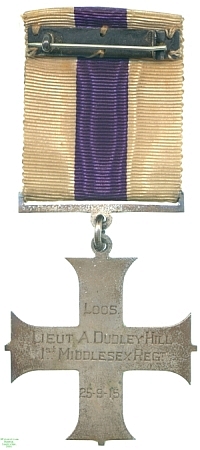
Obverse, royal monogram in centre on an inner cross with a crown outside each arm

Reverse, a plain cross

Obverse, royal monogram in centre on an inner cross with a crown outside each arm |

Reverse, a plain cross |
The Great War of 1914-1918 saw an unprecedented number of men under British arms, as well as an unprecedented and subsequently unequalled number of British casualties. In the circumstances the fact that for those of less than senior officer rank there was no gallantry award short of the Victoria Cross or Distinguished Service Order risked leaving many valorous deeds by lesser ranks unrecognised. In December 1914 therefore the Military Cross was instituted to recognise deeds worthy of decoration but not of the more exclusive awards. Eligibility was subsequently expanded to cover the RAF and even the Navy for acts of bravery on the ground, and the medal is still on current issue.
The failure of the Great War to be, as had been popularly expected, `over by Christmas', meant that the Army spent 1915 in a variety of bloody but inconclusive offensives which were intended to break the deadlock of trench warfare. In Autumn of 1915 two of these ran contemporaneously, the Battle of Ypres and the Second Battle of Artois. The latter offensive met with shortlived success on 25 September when British forces were able to break through the lines and capture the town of Loos, in northern France. Supply problems however meant that the breakthrough could not be exploited nor the town reinforced, and the British withdrew to their starting positions three days later.
This cross was awarded to Lieutenant A. Dudley Hill of the 1st Middlesex Regiment, for his bravery in the battle around Loos, which was reported in the London Gazette of 14 January 1916. Lester Watson obtained this medal from one Teresa Reece, perhaps a friend, in 1935; it may have been purchased by her shortly beforehand from the London dealers Baldwin.